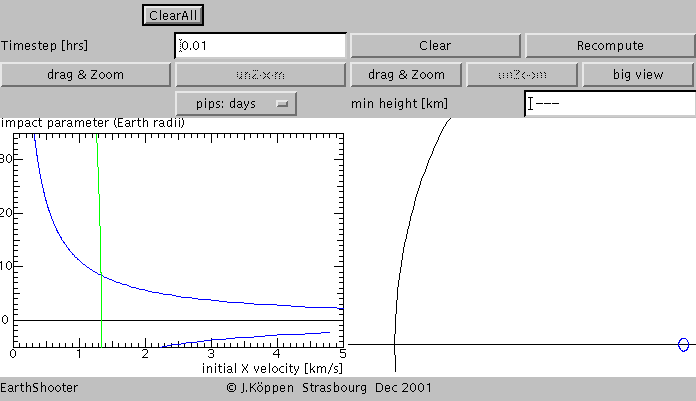
Shooting Asteroids at the Earth
Joachim Köppen Kiel/Strasbourg/Illkirch December 2001
Contents
The EarthShooter Applet shows the trajectory an incoming asteroid takes, depending on its initial velocity and position. We simulate the flight of the asteroid in the gravitational field of the Earth only. Thus, by leaving out the somewhat smaller details caused by the perturbation of the flight path by the gravitational attraction from the Moon, the Sun, and other bodies in the Solar System, we gain insight in the basic properties of what happens during a gravitational collision.
A very useful consequence of our simplification of neglecting the influence of Moon and Sun is simply that we do not have to specify the positions of Moon and the Sun. Moreover the entire problem becomes much less complex, because the conservation of angular momentum tells us that the trajectory must stay within a plane, and we do not have to mess about a three-dimensional view!
One important property is that all trajectories are simple conic sections, such as ellipses, hyperbolas, or parabolas. The behaviour of two bodies in gravitational interaction is ruled by the laws discovered by Johannes Kepler and Isaac Newton.
Another property is that the total energy of the asteroid, i.e. the sum of its kinetic energy and the potential energy in the Earth's field, and the angular momentum, essentially the product of distance from the Earth and velocity, determine the behaviour of the body: If the total energy is negative, i.e. the kinetic energy is smaller than (magnitude of ) the gravitational energy, the body cannot escape from the grasp of the Earth, and remains a bound body on an elliptic orbit. If the kinetic energy exceeds the potential energy, the body can escape from the Earth's field, with a hyperbolic orbit and arrive far away with still an excess of velocity. Thus, the energy determines the type of the orbit's shape.
For any given total energy, the angular momentum determines how close the body is able to approach the Earth, which means for us whether it will be close enough to either hit the Earth or pass through its atmosphere.
When you start up the applet, you hit the ClearAll button, and you see something like the following screen:

On the right hand side one has a view of the Earth (the blue ring) at the centre of the orbit of the Moon (indicated by the large black circle). The asteroid is coming in from the left hand edge, at a position indicated by the impact parameter and moving with an initial x-velocity. Both these essential parameters are plotted on the left hand side. Simply clicking with the mouse on any point of this plot will select the initial parameters (first marked by a violet circle) and the simulation is started. When the asteroid hits the earth surface, the simulation stops, the total flight time is displayed, and the parameter plot is marked with a red dot:

If the Earth was spared the collision, the simulation is halted when the asteroid reaches one of the borders of the plot. Then the total flight time and the height above the surface at closest approach are displayed:
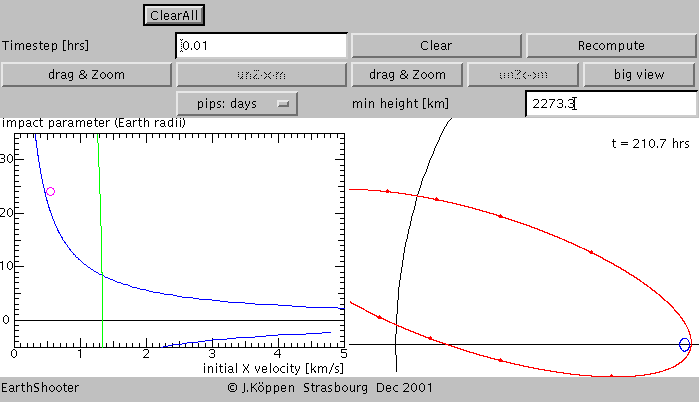
Note that doing another simulation does not automatically clear the right hand plot, so one can compare the different trajectories. Hit Clear button to clear up the picture.
The blue curve in the left plot is a theoretical constraint from the conservation of angular momentum and it refers to a parabolic orbit just touchung the Earth's surface. The green curve is a constraint derived from conservation of energy; the region to its left contains elliptical orbit. Hyperbolic orbits are to the right, which is thus the region in which genuine asteroids would appear. After several tries one confirms that the curves do explain the simulated behaviour:
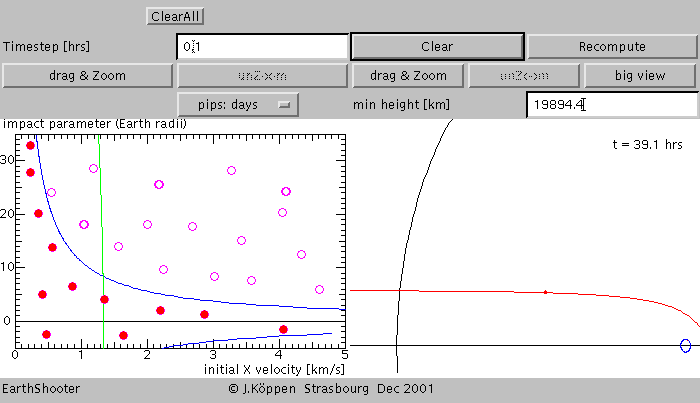
Here is the free fall from a point 70 Earth radii (446000 km) straight down to the surface. This takes more than 6 days.
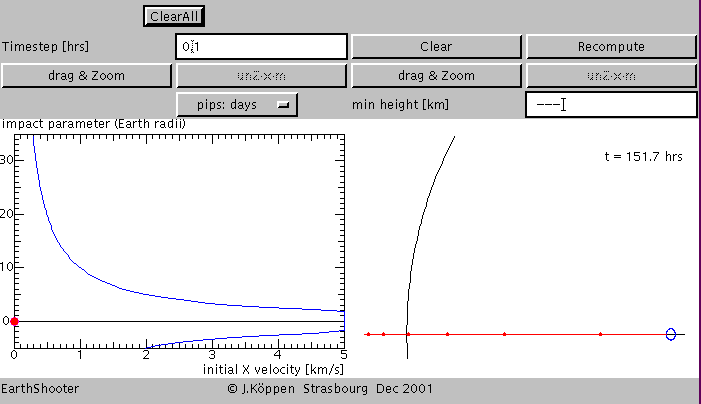
The following is a recomputation of the second example, but zoomed-in to view the Earth's environment as the body which started with 0.5 km/s velocity and followed a narrow elliptical trajectory, and now misses the Earth by about 600 km in less than one hour. From the global view shown earlier it is evident that this is an object already bound to Earth in an elongated elliptical orbit. Thus it would not be a genuine asteroid. However, it could have been forced into such an orbit by suitably passing near the Moon. But this kind of possibility is not dealt with in this Applet.
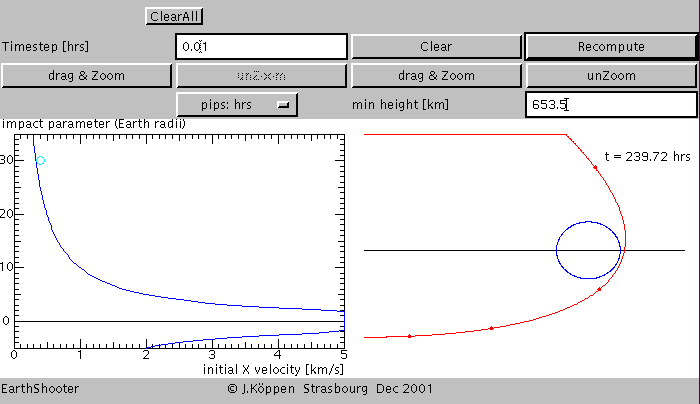
Finally, there is also the possibility to get a view as large as to fully contain the Moon's orbit:

We solve the equations of motions for the asteroid in the orbital plane. The Earth is assumed to be much more massive than the asteroid, and thus remains fixed in the plot. The equations of motion use the gravitational force due to the Earth into account. They are numerically solved with a simple but efficient Leap Frog method which conserves angular momentum with machine accuracy. The choice of the time step determines the accuracy with which the energy is conserved.
The principle of numerical computation is simply to compute at a given moment the gravitational force, then compute how much the velocity changes its magnitude and direction if this force would act throughout a small time step, and finally compute the new position by assuming that the body flies with this velocity during the time step. At the new position, we repeat the procedure, and so on ...
| Top of the Page | Controls | Applet | Applet Index |